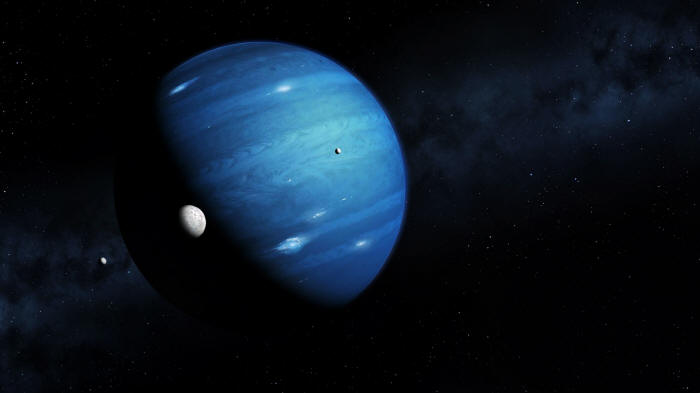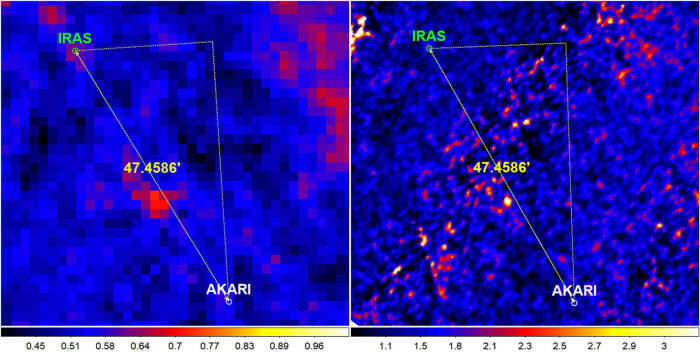|
is a hypothesized massive planet, first proposed in 2014, that is speculated to orbit far out in the solar system. It has not been detected formally. Instead, astronomers have inferred its presence from perceived perturbations of the orbits of some Trans-Neptunian Objects (TNOs). The planet is estimated to be 2 to 4 times the radius, and about ten times the mass of the Earth.
(Image credit:
Mark Garlick/Science Photo Library/Getty Images) it would be larger than Neptune and exist 700 times further from the sun than Earth....
If this mystery object really is Planet Nine, it
would have a mass greater than Neptune, and currently be about 700
times farther from the sun than Earth is.
This brings us to Planet Nine...
This proposed Planet Nine would be more massive than Earth, and orbit on a highly eccentric path that takes it hundreds of astronomical units from the sun (one astronomical unit is the distance between Earth and the sun).
That far away, it would be extremely difficult to
detect.
Phan's team were looking for objects that appeared in IRAS's database, then appeared to have moved by the time AKARI took a look.
The amount of movement on the sky would be tiny - about three arcminutes per year at a distance of approximately 700 astronomical units (AU).
But there's an extra motion that Phan's team had to account for.
As the Earth orbits the sun, our view of the position of very distant objects changes slightly in an effect called parallax.
It is the same phenomenon as when you hold your index finger up to your face, close one eye and look at your finger, and then switch eyes - your finger appears to move as a result of you looking at it from a slightly different position.
To remove the effects of
parallax, Phan's team searched for Planet Nine on the same date
every year in the AKARI data, because on any given date it would
appear in the same place, with zero parallax shift, every year.
This careful search led Phan's team to a single object, a tiny dot
in the infrared data. A comparison of the position of the candidate object in the IRAS data (left) and the AKARI data (right) and the distance in arcminutes between them.
(Image credit: Phan et al
- 2025)
However, there is an object seen by AKARI in a position 47.4 arcminutes away that isn't there in the IRAS imagery, and it is within the range that Planet Nine could have traveled in the intervening time.
In other words,
The knowledge of its motion in that intervening time is not sufficient to be able to extrapolate the object's full orbit, therefore it's not yet possible to say for certain whether this is Planet Nine.
First, astronomers need to recover it in more up-to-date imagery.
Based on the candidate object's brightness in the IRAS and AKARI images, Phan estimates that the object, if it really is Planet Nine, must be more massive than Neptune.
This came as a surprise, because he and his team were searching for a super-Earth-size body.
Previous surveys by NASA's Wide-field Infrared Survey Explorer (WISE) have ruled out any Jupiter-size planets out to 256,000 AU, and any Saturn-size planets out to 10,000 AU, but a smaller Neptune or Uranus-size world could still have gone undetected.
Phan told Space.com that he had searched for his candidate in the WISE data,
...and without knowing its orbit more accurately,
we can't say where it has moved to.
For comparison, the outermost planet, Neptune, is 30 AU (2.8 billion miles, or 4.5 billion kilometers) from the sun.
At 700 AU, Planet Nine would be 65 billion miles (105 billion kilometers) from the sun.
Alternatively, perhaps it was a rogue planet picked up by the sun,
maybe early in the history of
the solar
system when the sun was
still close to its siblings and planets could be ejected and
captured by different systems.
In 2021, astronomer Michael Rowan-Robinson of Imperial College, London, found an object in the IRAS data that had an estimated three to five Earth masses, and was much closer to the sun at about 225 AU.
However, the detection has not been confirmed, and has not been made in any other dataset, such as by AKARI.
Whether it really is Planet Nine, only time will tell.
With the
Nancy Grace Roman Space Telescope soon to launch to perform
high-resolution deep surveys of the sky, and the
Vera C. Rubin
Observatory set to see first light this year, as well as the prowess
of the already-established Dark Energy Camera, then if Planet Nine
exists it is running out of places to hide.
|



